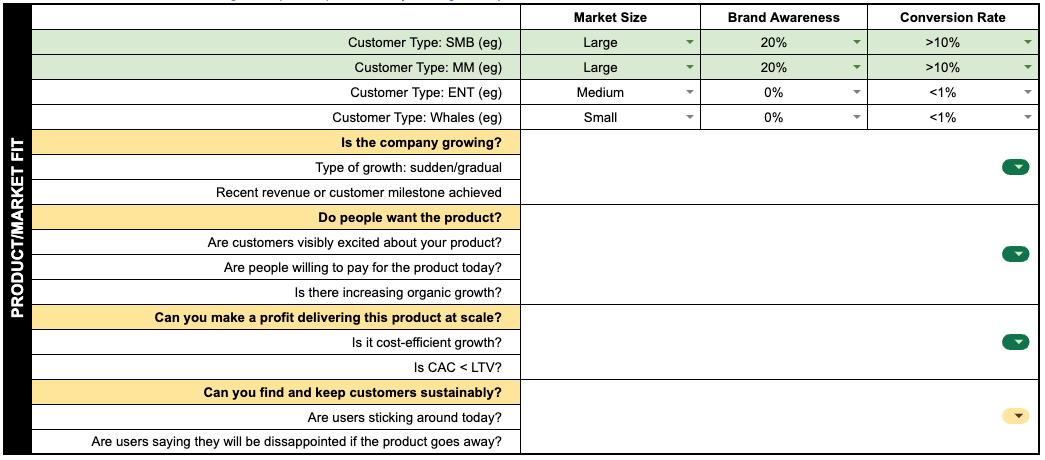Beyond Gut Feel: Measuring Product-Market Fit (PMF) for Strategic Scaling
Achieving Product-Market Fit (PMF) is often perceived as an elusive goal, typically assessed by gut instinct. However, relying solely on intuition can lead to critical missteps in scaling operations.
At BeaconGTM, we advocate for a more systematic approach to evaluating PMF, ensuring that your go-to-market strategy is not only effective but also scalable.
The Fallacy of "Fit/No Fit" Instinct
Traditional views on PMF suggest a binary "fit/no fit" scenario, often based on superficial market signals. This perspective has massive limitations as businesses face complex, evolving markets. Instead, a structured framework that incorporates quantitative and qualitative metrics can provide a more reliable assessment of PMF.
Developing a PMF Scorecard
To go beyond judgement, we have summarized insights from several experts into a comprehensive PMF scorecard. This tool is designed to evaluate multiple dimensions of market fit, including:
Customer segment conversion rates
Consistency and sustainability of growth
Engagement and satisfaction across the buyer journey
Financial and operational metrics indicating long-term viability
Some of our research:
Product-Market Fit is a Broken Concept. There’s a Better Way. -- Why the "fit/no fit" instinct is broken.
What it feels like when you've found product-market fit. -- Quotes from leading companies about when they found PMF.
How to know if you've got product-market fit. -- More from Lenny on PMF with some additional detail.
Practical Application
Whether you're assessing your own company's market fit or evaluating potential employer startups, our PMF scorecard provides a valuable framework. It offers actionable insights that can guide strategic decisions, from team building to product development.
PMF Scorecard
We found that after we do discovery with a new company, we're able to:
Easily fill this out and get a good picture of what customer segments in their target market are converting.
Understand if their growth is real and consistent and if significant milestones are reached. Sometimes early growth is based on brand factors that have nothing to do with your actual product.
Get deeper into the full buyer journey and see if customers are excited and willing to pay and get enough value to stick around.
Look at finances and high level metrics to determine if growth is actually sustainable and cost effective in the long run.
This can be used for almost anything -- whether you want to better understand if your company has found PMF or even if you are interviewing at early stage companies for a new opportunity.
FAQS
-
Product-Market Fit (PMF) refers to the degree to which a product satisfies a strong market demand. It is a crucial phase in a product's lifecycle where it meets the needs and desires of its target audience effectively, resulting in increased customer satisfaction and business growth ($$$ growth).
-
Relying solely on intuition for assessing PMF can lead to premature scaling or missed opportunities, as gut feelings may not accurately reflect the market's response to a product. A systematic approach using quantitative and qualitative metrics provides a more reliable and objective assessment, helping to avoid costly business errors.
-
The PMF Scorecard developed by BeaconGTM is a tool that evaluates multiple dimensions of market fit, including customer segment conversion rates, growth consistency and sustainability, customer engagement and satisfaction, and financial and operational metrics. This scorecard provides a structured framework to assess whether a product truly fits the market demands.
-
Using a PMF Scorecard helps businesses objectively measure their market fit, guiding strategic decisions such as scaling, product development, and team building. It enables companies to identify strengths and weaknesses in their market strategy and make informed adjustments to enhance their market position and growth potential.
-
Yes, the PMF Scorecard is versatile and can be beneficial for companies at various stages, from startups assessing their initial market fit to established companies looking to scale or enter new markets. It is also useful for individuals evaluating potential employers or investment opportunities in early-stage companies.
-
Sustainable growth is assessed by examining both the consistency of growth over time and the underlying factors contributing to it. The PMF Scorecard includes metrics that help determine if growth is driven by genuine product demand or if it's influenced by external factors like market trends or branding, which may not be sustainable long-term.
